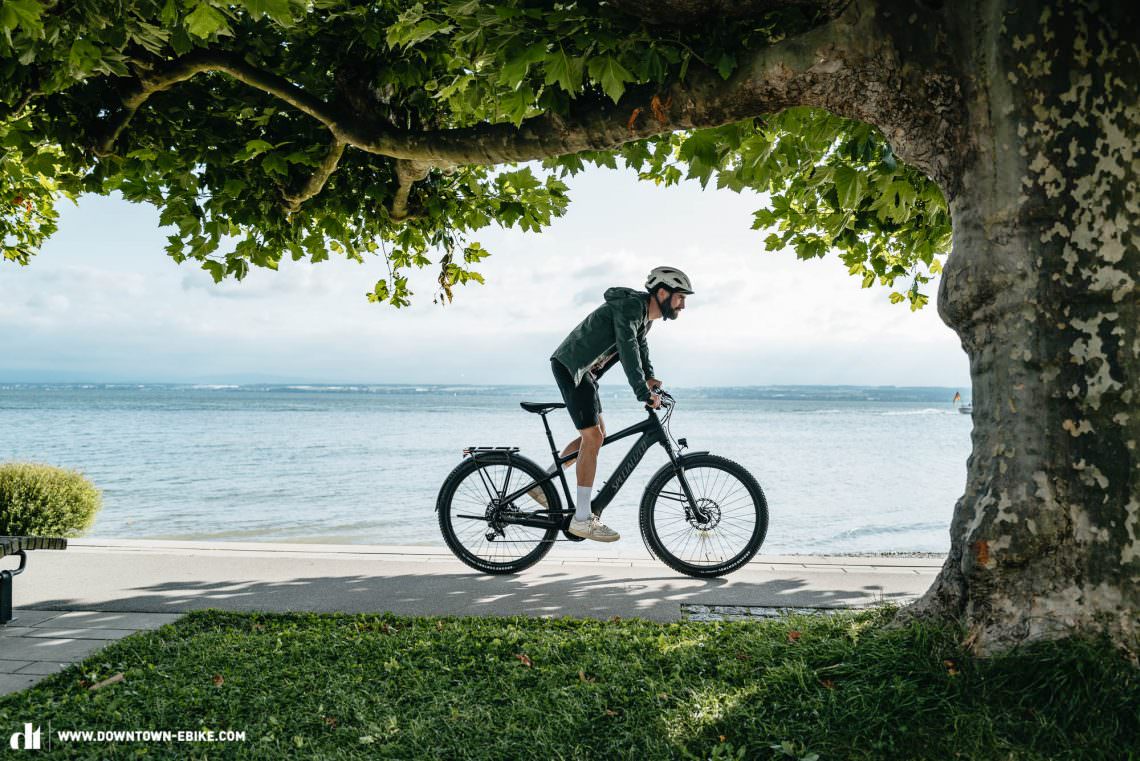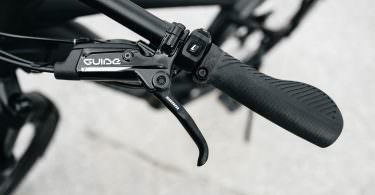A powerful motor, composed handling and impressive versatility promise to make the Specialized Turbo Tero a bike for all occasions. A trekking E-bike for weekend tours, a commuter for everyday life and an eMTB for easy singletracks. Can it deliver? We’ve already put the new Specialized Turbo Tero 4.0 EQ ST 2022 to the test to find out.
With the Specialized Turbo Tero, the US brand aim to bridge the gap between urban commuters, mountain bikes and everything in between. To do so, they’ve combined a hardtail frame with the latest version of their in-house motors, a battery capacity of up to 710 Wh, mountain bike components and various mounting points.

This should close the gap that Specialized see between their urban bike, the Turbo Vado SL (review here) and the brand’s eMTBs, such as the S-Works Turbo Levo (review here).



The Turbo Tero’s wide range of uses is said to be reflection of the diversity of people and thus provide potential riders with the right tool for every situation. To further cater to this diverse range of potential riders and needs, Specialized are offering the Turbo Tero in different versions: the Turbo Tero 3.0, 4.0 and 5.0. These differ in terms of motor power, battery capacity and components.


The 3.0 and 4.0 models are also available with step-through frames and the 4.0 comes as an Equipped version featuring many additional accessories for urban use or trekking. We tested the step-through and Equipped versions of the Specialized Turbo Tero 4.0, both available for € 5,000. Below, you will find all the details about the components, the bikes’ handling as well as our assessment of the concept.
Tech-Talk – Components and technical data of the Specialized Tero
Common to all three versions of the Specialized Turbo Tero are the 29″ Ground Control tires, mounting points for mudguards, a luggage rack, stand, and the MasterMind TCD colour display. The display can be removed from its mount but it remains attached to two cables, meaning that you can’t take it with you. The MasterMind also functions as the bike’s immobilizer, ANT+ and Bluetooth interface, and USB-C charging port. Moreover, the Tero’s software can be updated over-the-air via the MasterMind. All versions of the Tero are approved to pull a trailer and have mounting points for folding and wheel locks. The differences between the models can be found in the motors, batteries and groupsets. See the table below for all the specs.
| Model | Turbo Tero 3.0 | Turbo Tero 4.0 | Turbo Tero 5.0 |
|---|---|---|---|
| Motor | Specialized 2.0E | Specialized 2.0 | Specialized 2.2 |
| Battery capacity | 530 Wh | 710 Wh | 710 Wh |
| Groupset | Shimano Alivio | SRAM NX | SRAM GX |
| Brakes | Shimano | SRAM Guide T | SRAM G2 RS |
| Fork | SR Suntour XCM 32 110 mm | RockShox Recon TK 110 mm | RockShox Recon RL 110 mm |
In contrast to the 4.0 and 5.0 models, the 3.0 doesn’t have a dropper post. The 3.0, like the 4.0, is also available with a step-through frame featuring a dropped top tube. The Specialized Turbo Tero 4.0 is the only model in the Tero range that comes as an Equipped version. In addition to the components listed in the table above, the Equipped version features LED lights front and rear, DRYTECH mudguards, a child seat compatible rear rack that can carry up to 27 kg, a side stand and a chain guard as standard. However, you can also retrofit these accessories to the 3.0 and 5.0 models. Since doing so requires you to route quite a few cables, this is something that you’d only want to do if you’re going to leave it on the bike and doesn’t lend itself to removing and attaching as and when required.


We wonder why Specialized don’t offer all three models with the Equipped spec. All models are compatible with an additional front-mounted luggage rack on the head tube. Especially with the Equipped version, there are a lot of cables around the cockpit for the lights, brakes, gears and dropper post. We would have liked the routing to be a little neater.
On test – This is how the 2022 Specialized Turbo Tero 4.0 rides
Since the Specialized Turbo Tero claims to perform well on different terrain, we also wanted to evaluate its handling on different surfaces. Starting in the city, the Tero 4.0 accelerates quickly and easily maintains 25 km/h in Turbo mode even on slight inclines. Despite the knobbly tires, the bike rolls very efficiently and if you’re fit, you can even ride above the motor’s cut-off speed for some time on flat roads.

The wide tires feel nice and safe in the city and you don’t have to worry about tram tracks or stormwater grids. In these instances or when riding over curbs or bumps, the only thing the bike falls short on is comfort, due to the lack of rear suspension. However, you can easily dodge obstacles thanks to the excellently balanced handling. It’s very intuitive, sufficiently agile to be fun and composed enough to allow beginners to safely navigate the city. The Ground Control tires generate enough grip for everyday use even on asphalt, though their terrain of choice is off the beaten track.
When you leave the city behind and head down gravel roads, the ride feel doesn’t change much, the bike remains good-natured and agile, impressing us with its intuitive handling. You’ll still want to give potholes and bumps a wide berth. One thing that we found annoying is that the tires constantly pick up stones which then rattle along the mudguard until they’re spat out on the other side.

At the next intersection, take a right turn onto the trail, where the trend continues. While the Tero can’t be stopped on the trails and also offers a lot of grip on loose surfaces, the unsuspended rear end jackhammers over roots and rocks. You’ll quickly get pushed to your limits in this kind of terrain and if you want to be fast here, you’ll need a lot of skill and the right technique, especially when you’re carrying luggage on the rack. Whether in the city, on gravel roads or on a forest path, the gear range of the Specialized Turbo Tero 4.0 will allow you to find a comfortable cadence both on steep climbs and on fast descents. If you choose to, you can have the MasterMind display indicate whether you’re pedalling in the optimal cadence range for the motor. The SRAM Guide T brakes are sufficiently powerful, though we would have preferred slightly larger rotors on long descents or when encountering unforeseen obstacles in city traffic, even more so when you’re got weight on the rack.



Since the Specialized Turbo Tero 4.0 relies on the large 710 Wh battery but has a weaker motor than the flagship Tero 5.0, it achieves the greatest range of the three versions. In our test, we were able to cover between 90 and 100 km in Turbo mode on a very hilly route with a 70 kg rider before needing to recharge. To recharge, you can connect the bike directly to a power outlet or conveniently remove the battery and charge it indoors. The battery is secured with a key and easy to remove thanks to a convenient handle. The battery compartment itself is also cleverly designed and rubberised in all the right places so that nothing rattles while riding, even when things get rough!

A question of Concept – What is the Specialized Turbo Tero?
The Specialized Turbo Tero wants to be a bike for all occasions: a trekking E-bike for weekend tours, an eMTB for the trails and a commuter for everyday life in the urban jungle. To achieve all of this, compromises had to be made. It has us asking, what is this bike? No question, equipped with the components it has, you can race the Tero down gravel roads and along the occasional forest path. However, you’ll quickly reach the limit of what we consider comfortable on uneven terrain due to the hardtail construction. A suspended rear end would also be desirable on natural trails that are criss-crossed with roots. Aboard the Equipped version of the Tero 4.0, you’re also likely to get annoyed by the small stones that get stuck between the tires and the mudguards when riding on gravel.



The front mudguard extends far down behind the wheel, bringing it low to the ground. This is great when things get wet but it almost makes the bike unsuitable for off-road terrain as it hits the ground when riding over even small obstacles. You won’t have this problem if you choose the version without mudguards and a luggage rack but that makes the Specialized Turbo Tero considerably less suitable for everyday commuting. You’ll get sprayed with water in the wet and you’ll have to use a backpack for your luggage. Besides that, having rear suspension would also make sense in the city and take the sting out of pothole-strewn roads.

Due to the compromises that have to be made with the bike on different terrain, we don’t see the Specialized Turbo Tero as a category bending bike for every situation. We see it more as a trekking bike that can handle moderate off-road terrain when necessary. As such, we don’t think the Specialized Turbo Tero has what it takes to close the gap between urban and eMTBs. A more comfortable and capable concept with more reserves would be advantageous for this bike’s entire target group. If you want to go for a hardtail to save money, the Turbo Tero’s price range of € 3,300 to € 5,400 will likely also be a stumbling block.

Our conclusion on the 2022 Specialized Turbo Tero
With the Turbo Tero, Specialized present a solid old-school trekking E-bike. To close the gap between the urban and eMTBs in Specialized’s portfolio, the Turbo Tero lacks the necessary reserves and comfort due to its classic hardtail construction. It has a wide range of uses but due to its lack of comfort compromises in every situation and therefore doesn’t live up to modern standards. The Tero impressed us with its excellent motor and long range.
Tops
- powerful, long-range motor
- high quality workmanship and attention to detail
- intuitive and fun handling on well-maintained surfaces
Flops
- it's an old school trekking bike, not a new concept
- (too) many compromises
- lack of comfort at the rear
- messy cable routing up front

For more information, visit specialized.com
Words: Photos: Specialized























